The notion that senior living communities aren’t part of the healthcare continuum was dramatically undercut by the pandemic. Operators now know their role is critical to the health of their residents, and to the long-term success of their business.
This realization comes at a time when the healthcare system itself is undergoing a substantial change. The fee-for-service paradigm is being replaced by value-based care. The goal is to create better health outcomes at a lower cost.
“What does value-based care mean now for senior living?” asked NIC Co-Founder and Strategic Advisor Bob Kramer introducing a main stage session on the current state of value-based care at the 2025 NIC Spring Conference. “Value-based care represents an incredible opportunity and an incredible challenge for senior living.”
The session was led by Stephanie Boreale, Watermark Retirement Communities. She was joined by Larry Leisure, Chicago Pacific Founders; Andy Eby, Bickford Senior Living; and Brian Fuller, ATI Advisory.
Setting the discussion in context, Fuller explained that value-based payments shift responsibility for costs and quality to the entity delivering care. Reimbursement is no longer a payment based on the delivery of a service — the traditional fee-for-service arrangement.
Fuller noted that different value-based care models are emerging and highlighted these key data points:
- Growth in healthcare spending accelerated in 2023, topping $4.9 trillion.
- Healthcare spending represents a 17.4% share of the economy, which is set to eclipse 20% by 2032.
- Medicare enrollment will increase by almost 50% by 2030.
- About 54% of Medicare beneficiaries are enrolled in Medicare Advantage plans, a value-based care model.
- About 14 million Medicare beneficiaries are covered by ACOs or other value-based care arrangements.
- The value-based healthcare market is projected to grow at a compound annual growth rate of 17.2% from 2024 to 2031, reaching $43.39 billion by 2031.
Value-based care remains the primary solution to slow rising healthcare costs, Fuller said, but he cautioned that adoption of the model must accelerate. The government’s goal is to have every Medicare beneficiary in a value-based care arrangement by 2030. “We need to double down on value-based care to overcome demographic and political realities,” he said. But, he added, “Culture change is a significant lift.”
Unlock the Potential
The upside is that value-based care payments represent a revenue growth opportunity for senior living owners and operators. Medicare premium dollars can potentially be tapped for items such as transportation, wellness programs and support services. Enhanced value-based care services can improve resident health, satisfaction, retention, and length of stay.
“There is an opportunity here,” said Leisure. “Senior living operators are in a unique position.” Many of the services already provided by senior living communities are part of the value-based care model. “We touch lives every day,” said Leisure, adding that investors are looking for successful models of how value-based care can boost the operator’s bottom line.
One example is Bickford Senior Living, which improved net operating income by 17% year-over-year by implementing a healthcare integration strategy. “Operators have a responsibility to prove to payors and insurers what we can do and how we can drive outcomes,” said Eby, who belongs to several industry initiates on value-based care. “We’ve leaned into value-based care to differentiate our properties by making them more attractive to residents.”
Watermark’s Boreale asked: How do payors view senior living?
Payors want to contract with medical groups and shift the risk to those parties. Leisure suggested that owners and operators consider on-site health care, Medicare Advantage plans that wrap around medical teams, and virtual care.
Fuller said that payors focus on three factors: Enrolling beneficiaries and keeping them; CMS star ratings of quality, service and member experience; and the management of their loss ratio. “Figure out how to play in one or several of those areas,” he advised. “Take ownership.”
There’s another way to think about value-based care, said Fuller. “It’s the right thing to do.” His grandmother died while living in a memory care community. But the last 12 months of her life were horrific for her and Fuller’s family. She cycled in and out of the emergency room and the hospital.
Fuller would have loved to have had an interdisciplinary care team to discuss what the family wanted for her and what she wanted. That could have avoided the turnstile of care, not to mention the huge cost to the Medicare system. “Let’s not lose the resident’s story,” said Fuller. “That is the anchor of value-based care.”
Leverage Technology
Technology also plays a major role in value-based care strategies.
Senior living providers have a wealth of resident data that healthcare providers and payors are eager to access. The challenge is how to aggregate that data, analyze it, integrate care, and demonstrate that senior living improves health outcomes.
New and emerging technologies will help reach that goal, according to the panelists. For example, Bickford joined the Senior Living Transformation Company to develop a tech-enabled model that integrates with value-based care frameworks.
New fall detection technologies can help reduce hospitalizations and emergency room visits. Technologies that monitor biomarkers can help to anticipate issues related to chronic illnesses. Development is underway of $9-an-hour artificial intelligence nurses to consult with patients in real time.
Where to start? Senior living owners and operators need a strategy and a roadmap. “Get started,” said Fuller. “Look for successful models and potential partnerships,” added Leisure.
Eby said implementing a value-based care strategy isn’t as complicated as it seems. There is no path to follow. “Make the path by walking,” he said. “Get moving.”
—
Learn how to implement value-based care in your properties. NIC Academy’s Value–Based Care specialty course offers tools and strategies for navigating the complexities of value-based care to help you realize its potential benefits.





